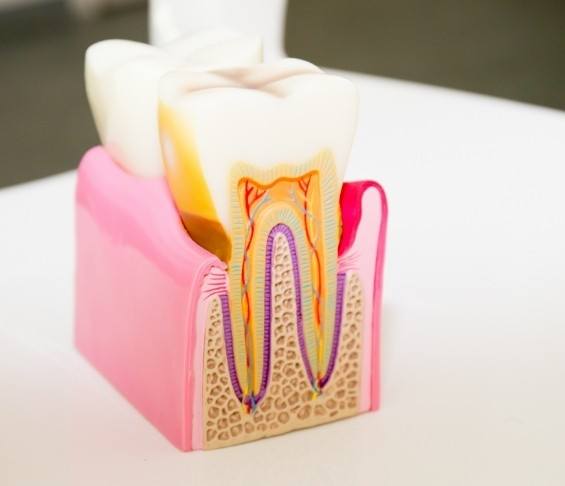Endodontic Retreatment Paramus
When Teeth Need Further Treatment After Root Canals

Root canal treatment has a very high success rate; once it has been completed, you can generally look forward to enjoying a healthy, pain-free smile. But what if you once again start experiencing discomfort in the tooth in question? Or what if you notice symptoms that suggest that a new infection has occurred? In these situations, we highly recommend that you call North Jersey Endodontic Group of Paramus immediately; our knowledgeable experts can take a look at your teeth and determine whether an endodontic retreatment in Paramus is necessary.
Why Choose North Jersey Endodontic Group of Paramus for Endodontic Retreatment?
- Experienced Endodontic Experts
- Patient-Focused Approach to Comfort
- Same-Day Emergency Appointments Available
What Is Endodontic Retreatment?

Endodontic retreatment is a type of procedure that might be needed if you’re still having problems with a given tooth even after it has received root canal treatment. Our team can reopen the tooth and carefully examine the root canals to check for spots that may have been overlooked during our initial cleaning. Any bacteria that we find will be removed as quickly as possible. The sooner you have an endodontic retreatment performed, the better your chances of saving the tooth will be.
Why Would I Need Endodontic Retreatment?

A root canal treatment is meant to help relieve the pain caused by an infection, so if you notice any discomfort in the treated tooth, that is usually a strong indicator that you might need an endodontic retreatment. Another possible warning sign is the appearance of an abscess (a pimple-like bump) near the tooth. You should not delay endodontic retreatment any longer than necessary, so if you believe that you might need it, we urge you to pick up the phone immediately and schedule an appointment for us.
The Endodontic Retreatment Process

Like with a root canal treatment, we will begin your endodontic retreatment by numbing your mouth. Then, in order to work with the tooth, we will remove the crown as well as the biocompatible filling material. Another cleaning will be performed, during which we will pay especially close attention to the areas that may have been initially overlooked; our goal is to eliminate any infection that might remain. The tooth will be filled with biocompatible material again once your retreatment is complete. Follow-up appointments may be necessary so that we can confirm that no new problems have appeared.
Endodontic Retreatment FAQs
Is Endodontic Retreatment the Best Choice for Me?
Yes, if your endodontist recommends an endodontic retreatment, it is generally best to have it performed as soon as possible. If the initial root canal treatment has failed, the infection that’s still inside the tooth could grow even worse and cause further problems. Eventually, you could even lose the tooth altogether.
While lost teeth can be replaced, it’s better for your oral health to keep your natural smile as intact as possible. Thus, if you have any reason to believe that you may need an endodontic retreatment, you should get in touch with an endodontist as soon as possible to see what they recommend.
Does Endodontic Retreatment Hurt?
You may be nervous about having an endodontic retreatment performed, but like a root canal treatment, this procedure is nowhere near as painful as many patients anticipate. The first step is to apply a local anesthetic to your mouth in order to keep it numb. Thanks to this simple measure, you’re likely to find that an endodontic retreatment is no more uncomfortable than having a filling placed.
There may be some discomfort and swelling in the days following the procedure. Fortunately, you should be able to manage it with the help of ibuprofen or another type of over-the-counter pain reliever. Additionally, it’s recommended that you apply a cold compress to the affected area to reduce swelling. Remember not to use a cold compress for more than 15 minutes at a time.
Any discomfort after endodontic retreatment should fade on its own over time. If it seems to be growing worse, call your endodontist immediately and let them know what’s happening.
How Much Will an Endodontic Retreatment Cost?
You can normally expect endodontic retreatment to cost more than the initial root canal treatment. This is due to the fact that endodontic retreatment is generally a more complex procedure. The filling material that was previously placed will need to be removed, and your endodontist will spend time looking for any canals that were overlooked before.
The exact cost of an endodontic retreatment can vary based on your specific circumstances. Bear in mind that your dental insurance plan may potentially help cover the cost of this procedure. However, every dental insurance plan is different, so be sure to review your own policy and confirm that you fully understand what is and isn’t covered.
What are the Alternatives to Endodontic Retreatment?
One possible alternative to an endodontic retreatment is an apicoectomy. This involves removing the tip of the root of the affected tooth as well as inflamed or infected tissue in the area. Your endodontist can discuss whether this is an appropriate option in your case.
If you don’t have an endodontic retreatment or apicoectomy performed, the only remaining alternative will be to have the tooth removed. Needless to say, this is not an ideal outcome; an incomplete smile can have serious consequences for your oral health, and the options for replacing it can be costly. Saving the tooth when possible is preferable for your smile and your wallet.
